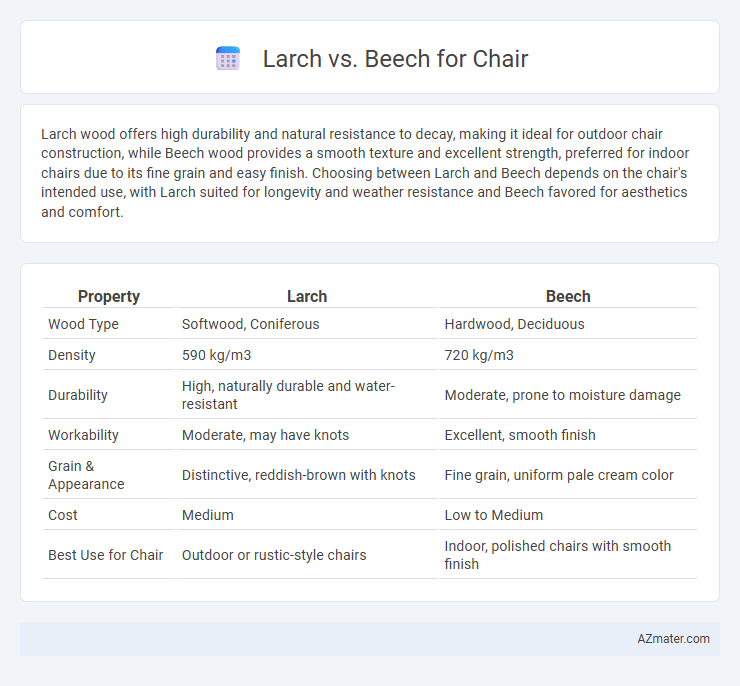Larch wood offers high durability and natural resistance to decay, making it ideal for outdoor chair construction, while Beech wood provides a smooth texture and excellent strength, preferred for indoor chairs due to its fine grain and easy finish. Choosing between Larch and Beech depends on the chair's intended use, with Larch suited for longevity and weather resistance and Beech favored for aesthetics and comfort.
Table of Comparison
| Property | Larch | Beech |
|---|---|---|
| Wood Type | Softwood, Coniferous | Hardwood, Deciduous |
| Density | 590 kg/m3 | 720 kg/m3 |
| Durability | High, naturally durable and water-resistant | Moderate, prone to moisture damage |
| Workability | Moderate, may have knots | Excellent, smooth finish |
| Grain & Appearance | Distinctive, reddish-brown with knots | Fine grain, uniform pale cream color |
| Cost | Medium | Low to Medium |
| Best Use for Chair | Outdoor or rustic-style chairs | Indoor, polished chairs with smooth finish |
Introduction: Larch vs Beech for Chair Making
Larch wood offers excellent durability and natural resistance to decay, making it ideal for sturdy chair frames exposed to humidity or outdoor conditions. Beech wood is prized for its smooth texture, fine grain, and exceptional workability, resulting in comfortable, polished indoor chairs with a classic finish. Both woods provide strength, but larch excels in moisture resistance while beech stands out for aesthetic refinement and ease of shaping.
Wood Characteristics: Larch vs Beech
Larch wood is known for its high resin content, making it durable, water-resistant, and ideal for outdoor furniture, but it tends to have a rougher texture compared to beech. Beech wood offers a fine, tight grain and smooth texture, which provides excellent workability and a strong, sturdy structure perfect for indoor chair craftsmanship. The hardness of beech is higher than larch, ensuring better resistance to dents and wear in frequently used seating.
Durability and Strength Comparison
Larch wood offers impressive durability with natural resistance to decay and insects, making it a strong choice for chair construction in both indoor and outdoor environments. Beech wood, known for its exceptional hardness and fine grain, provides superior strength and stability, ensuring chairs maintain shape and support under regular use. While larch is more weather-resistant, beech excels in indoor settings due to its dense structure and ability to withstand heavy loads without deforming.
Workability and Craftsmanship
Larch wood offers excellent workability due to its fine grain and medium density, making it ideal for chair craftsmanship that requires shaping and detailed carving. Beech wood is highly valued for its smooth texture and hardness, providing superior durability and ease of machining, which results in finely crafted, robust chairs. Both woods support strong joinery and finishing, but beech's uniform grain allows for a more polished and refined appearance in high-quality chair production.
Aesthetic Appeal and Grain Differences
Larch wood offers a distinct, warm reddish hue with pronounced knots and a rugged texture, creating a rustic aesthetic that highlights natural growth patterns. Beech wood features a smooth, fine grain and a pale, creamy color that lends a clean, modern look with subtle uniformity. The dramatic, uneven grain of larch contrasts sharply with the consistent, tight grain of beech, making each suitable for different stylistic preferences in chair design.
Weight and Density Analysis
Larch wood typically exhibits a density ranging from 550 to 650 kg/m3, making it lighter and more suitable for chairs requiring mobility and ease of handling. In contrast, Beech wood has a higher density, approximately 720 to 830 kg/m3, contributing to greater durability and sturdiness but resulting in a heavier chair. The choice between Larch and Beech for chair construction involves balancing the lightweight advantage of Larch against the robust, dense nature of Beech for long-term structural integrity.
Cost and Availability
Larch wood is generally more affordable and readily available in regions where it grows abundantly, such as Northern and Central Europe, making it a cost-effective option for chair manufacturing. Beech, widely found across Europe, often commands a higher price due to its dense, fine-grained texture and durability, which is favored in high-quality furniture production. Availability of beech may vary seasonally and geographically, potentially increasing lead times and cost compared to the more consistently accessible larch.
Sustainability and Environmental Impact
Larch wood is highly sustainable due to its fast growth rate and natural resistance to decay, reducing the need for chemical treatments often required with beech. Beech, while durable and strong, has a slower growth cycle and a higher environmental footprint from forestry practices and processing. Choosing larch for chairs promotes lower carbon emissions and enhances eco-friendly furniture production.
Best Uses: Larch Chairs vs Beech Chairs
Larch chairs excel in outdoor and rustic settings due to their natural water resistance and durability, making them ideal for garden furniture and cabins. Beech chairs suit indoor use perfectly, offering a smooth finish and excellent strength for dining or office seating. Both woods provide stability, but larch's tight grain enhances wear resistance outdoors, while beech's fine texture supports detailed carving and polished appearances.
Conclusion: Choosing the Right Wood for Your Chair
Larch wood offers exceptional durability and a distinct reddish hue, making it ideal for rustic, outdoor-style chairs that require weather resistance. Beech wood provides a smooth finish and fine grain with excellent strength, perfect for indoor chairs needing a refined, polished appearance. Selecting between larch and beech depends on the chair's intended use and aesthetic preference, where larch suits robust, natural settings, and beech excels in elegant, formal environments.

Infographic: Larch vs Beech for Chair
 azmater.com
azmater.com